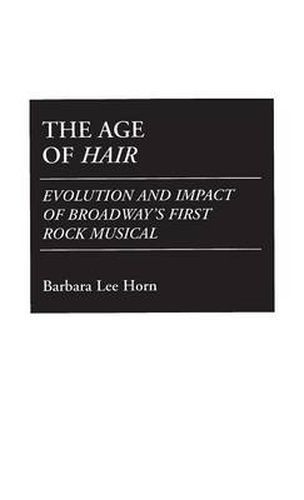Readings Newsletter
Become a Readings Member to make your shopping experience even easier.
Sign in or sign up for free!
You’re not far away from qualifying for FREE standard shipping within Australia
You’ve qualified for FREE standard shipping within Australia
The cart is loading…






A reflection and symbol of the turbulent 1960s and the culture and lifestyles of the Hippies, Hair made history as the first rock musical on Broadway and one of the most successful musicals. The 60s left an indelible imprint upon the American psyche, and Hair , in the words of critic Clive Barnes, summed it up better than any other piece of American theatre . Aside from bringing experimental techniques and rock music to Broadway, Hair , in author Barbara Horn’s view, represented a major step in the evolution of the concept musical from the book musical and was the first concept mus=ical to reach mass audiences, an achievement unheralded and little recognized. Horn analyzes the social context of Hair and the Hippies, describes the tenor of the Broadway theatre of the times and the experimental trends Off-Broadway that culminated in Hair’s innovations on the Great White Way. She then goes on to relate the dramatic story of Hair’s creation and growth, dash myths and clarify the actual events, including the casual meeting of co-authors Gerome Ragni and James Rado with producer Joseph Papp on a train. The transfer of Hair to Broadway is fully detailed, and the Broadway production is compared with the earlier production at Papp’s Public Theatre with lists of song sequences provided. Several revivals and the film version are also discussed and staff and cast lists appear as appendices. Horn’s extensive archival research is amplified by insights from numerous interviews, including those twith the authors, Ragni and Rado; composer, Galt MacDermot; Broadway producer, Michael Butler, directors, Gerald Freedman and Tom O'Horgan, musical director, Galt MacDermot; set designer, Robin Wagner; lighting designer, Jules Fisher, cast members, Melba Moore and Lorrie Davis; and others associated with one or more of the productions, as well as with theatre critics and theorists.
$9.00 standard shipping within Australia
FREE standard shipping within Australia for orders over $100.00
Express & International shipping calculated at checkout
A reflection and symbol of the turbulent 1960s and the culture and lifestyles of the Hippies, Hair made history as the first rock musical on Broadway and one of the most successful musicals. The 60s left an indelible imprint upon the American psyche, and Hair , in the words of critic Clive Barnes, summed it up better than any other piece of American theatre . Aside from bringing experimental techniques and rock music to Broadway, Hair , in author Barbara Horn’s view, represented a major step in the evolution of the concept musical from the book musical and was the first concept mus=ical to reach mass audiences, an achievement unheralded and little recognized. Horn analyzes the social context of Hair and the Hippies, describes the tenor of the Broadway theatre of the times and the experimental trends Off-Broadway that culminated in Hair’s innovations on the Great White Way. She then goes on to relate the dramatic story of Hair’s creation and growth, dash myths and clarify the actual events, including the casual meeting of co-authors Gerome Ragni and James Rado with producer Joseph Papp on a train. The transfer of Hair to Broadway is fully detailed, and the Broadway production is compared with the earlier production at Papp’s Public Theatre with lists of song sequences provided. Several revivals and the film version are also discussed and staff and cast lists appear as appendices. Horn’s extensive archival research is amplified by insights from numerous interviews, including those twith the authors, Ragni and Rado; composer, Galt MacDermot; Broadway producer, Michael Butler, directors, Gerald Freedman and Tom O'Horgan, musical director, Galt MacDermot; set designer, Robin Wagner; lighting designer, Jules Fisher, cast members, Melba Moore and Lorrie Davis; and others associated with one or more of the productions, as well as with theatre critics and theorists.